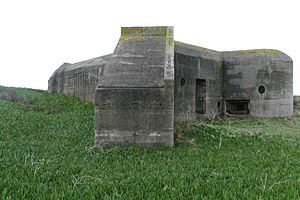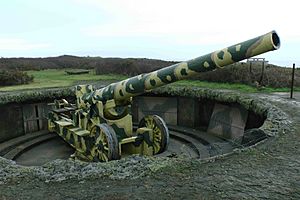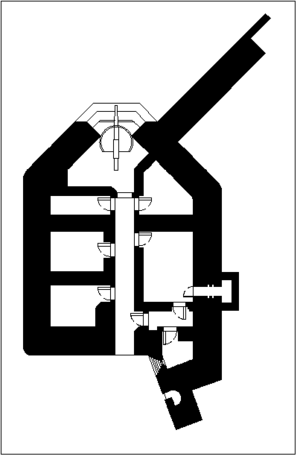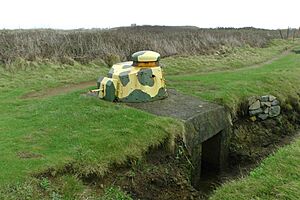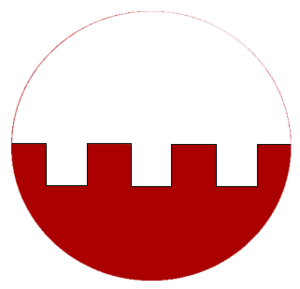German fortification of Guernsey facts for kids
When the German army took over the Channel Islands on June 30, 1940, they checked out the islands' defenses. They quickly realized that the existing forts were old-fashioned and not strong enough for modern war. At first, the Germans didn't build many new defenses. They thought they would invade the United Kingdom soon, so spending a lot on the islands seemed like a waste.
But by 1941, the plan to invade Britain changed. The Germans started preparing for a war in the east. This meant they needed strong defenses in the west to protect the islands with fewer soldiers. So, they began a huge building project. This work needed thousands of workers and massive amounts of concrete and steel. Tiny Guernsey got special attention. It had the biggest guns, tanks, and 12,000 soldiers. That was one soldier for every two people living on the island!
Contents
Building Strong Defenses in the Channel Islands
On June 2, 1941, Adolf Hitler asked for maps of the Channel Islands. He decided the islands needed much stronger defenses. He ordered the Organisation Todt (OT) to build 200-250 strongpoints on each of the larger islands. The OT was a big construction group that managed many engineering companies. They also provided a huge workforce.
The "Inspector of Western Fortresses" was in charge of checking the progress. Hitler's orders to strengthen the islands arrived on June 16, 1941. The Germans believed the Allies might attack the islands that summer. German engineers had a lot of experience from building the Siegfried Line. They quickly figured out what was needed for the islands.
How the Fortifications Were Built
Standard Designs for Bunkers
The Germans used a system called Regelbau, which means "standard build." They had books with plans for over 600 different types of bunkers and casemates. Each design had a special purpose. These plans were improved over time, even by testing captured enemy forts.
German bunkers had standard features. These included entrance doors at right angles and armored air vents. They also had thick steel doors, ventilation systems, and telephones. Inside, the walls were often lined with wood. There was always an emergency exit. Over 200 standard armor parts were used.
German defense buildings fell into three main types:
- Feldmässige Anlage (Field-type constructions): These were made of timber and soil. They sometimes had a 40 cm concrete roof.
- Verstärkt feldmässig or "Vf" (Reinforced field-type constructions): These had a 1 meter thick reinforced concrete roof.
- Ständige Anlage or "St" (Permanent constructions): These had walls and roofs at least 2 meters thick.
A special engineer group, Festungspionierstab 19, arrived in Guernsey in July 1941. They started making plans for the construction. The plan was finished and sent to Hitler. He then ordered even stronger "permanent fortification" for the islands. The goal was to make them an "impregnable fortress" within 14 months.
The Construction Workers
The Organisation Todt (OT) did most of the construction work. Supervisors and skilled workers came from Germany. They also recruited volunteers from countries Germany had taken over. These included the Netherlands, Belgium, and France. These workers were paid and had good living conditions.
Most of the manual labor came from different groups. These included "guest workers," military prisoners, and forced laborers. Many forced laborers were prisoners taken during Operation Barbarossa (the invasion of the Soviet Union). They arrived in the islands in late 1942. Other workers came from Poland and French camps. Some were even from North Africa.
Conditions for forced laborers were very harsh. They were poorly fed and clothed. They were often beaten and punished. The Germans saw them as disposable. Many were worked to death. Conditions were worst in Alderney, where the SS ran some camps. Many workers died, with 96 known graves in Guernsey and 397 in Alderney. Forced workers often only had the clothes they were wearing. They worked 12-hour shifts, seven days a week, with only half a day off per month.
Local islanders were also hired. The OT paid them much more than normal local wages.
Getting Ready to Build
The Fortress Engineers set up their main office at Elizabeth College, Guernsey. They also created large storage areas for building materials. These included timber, steel, camouflage paint, and steel doors. Workshops for carpenters and locksmiths were also set up.
The OT's main office in Guernsey was at Sausmarez Park. They had a hospital, a fuel depot, and more storage areas. Getting materials and transport organized was a big job. Barges and small ships brought materials to the islands. These supply ships needed protection from attacks.
Cranes and concrete mixers were brought in. A special railway was built. It ran from the harbor in St Peter Port all the way along the west coast. This helped move heavy materials.
The islands had good sources for building materials. Guernsey had many quarries for stone. It also had sand pits away from the coast. OT brought in vehicles, mostly old French trucks. Five camps were built for workers, but many OT workers lived in houses taken over by the Germans.
Types of Fortifications
From late 1941 and through 1942, building work happened very fast. Workers dug out sites, often by hand or with explosives. Metal bars were wired together to strengthen the concrete. Concrete was poured in one continuous operation to make the structure strong. Holes for pipes and doors were made before the concrete dried. Huge supports were needed for the thick roofs.
Each location had defenses that fit its needs. Walls, floors, and ceilings had standard thicknesses. Some designs were changed to fit the local land. Things like air filters, showers, gas-proof doors, and telephones were standard. Some parts even came from the Westwall and Maginot Line defenses in France.
Big Guns and Observation Towers
Batterie Mirus was the biggest artillery battery in the Channel Islands. It used four huge 30.5 cm guns. These guns could fire shells up to 51 kilometers (about 31 miles)! The battery started working in June 1942.
Ten other coastal artillery batteries were built. These included French guns and German mortars. They were placed in open concrete pits so they could turn all the way around. Bunkers were built for ammunition and for soldiers to live in.
Battery Dollmann at Pleinmont is now open to visitors. It has one of the gun pits and trenches that have been fixed up. Its guns could fire up to 23 kilometers (about 14 miles). The battery also had barbed wire, anti-aircraft guns, searchlights, and minefields.
Land artillery was placed to fire on beaches and inland areas. In Guernsey, there were five batteries, each with four Czech 10 cm artillery guns. These could fire up to 9.6 kilometers (about 6 miles).
Six Marinepeilstände (MP) observation towers were built on high points. These tall towers are a famous symbol of the German construction. Each tower had special equipment to find the range of targets at sea. Naval Range-finding Tower MP 3 at Pleinmont is now a museum.
Anti-Aircraft Defenses
The main anti-aircraft guns were the 8.8 cm Flak 36. They had an effective range of 7,500 meters (about 4.6 miles). These guns were in six batteries and used radar to find targets. Large 150 cm searchlights helped too. L’Ancresse common has the six-gun Flak Battery Dolman in the middle of a golf course. Its guns could also fire at ships.
Smaller 3.7 cm and 5 cm Flak guns provided medium range defense. Tiny 2 cm Flak guns protected specific buildings. In total, Guernsey had about 175 anti-aircraft guns. Obstacles with explosives were also placed to stop airborne landings.
Beach and Headland Defenses
Most beach defenses were built to fire along the beach, not out to sea. This allowed them to create a strong, overlapping field of fire.
Twenty-one casemates were built into the coast for 10.5 cm French guns. Another 13 of these guns were in open positions. A casemate with a 10.5 cm gun at Fort Hommet has been restored and is open to the public.
Sixteen anti-tank gun casemates held Czech 4.7 cm Pak guns. These had machine guns too. Many more 4.7 cm Pak guns were placed in field positions.
Machine guns were protected inside casemates, in "Tobruk pits" (small concrete bunkers), or in trench systems. At Fort Saumarez, a trench system with a machine gun and Tobruk pit is open to visitors.
Large 60 cm searchlights were used to light up the sea at night. Thousands of steel and wood obstacles, like tetrahedra and Czech hedgehogs, were placed on beaches. Many had mines attached. Anti-tank walls were also built at the high water mark, like the one protecting L'Ancresse bay.
Defensive Areas
Instead of long lines of defenses, the Germans built "hedgehog" defenses. These were strongpoints with all-around visibility. They could support each other with overlapping fire.
Guernsey had twelve Stützpunkt (Strongpoint) areas. For example, Stützpunkt Rotenstein at Fort Hommet had four 10.5 cm gun casemates, searchlights, machine gun bunkers, and an anti-tank casemate. It also had a bunker with an automatic mortar, personnel bunkers, barbed wire, minefields, and trenches.
Widerstandsnest (Resistance nest) (WN) were smaller defense zones. They filled in gaps between strongpoints or protected specific places like radar stations. WN Grune Dune at Rocquaine Bay had anti-tank gun casemates, a steel turret with machine guns, and a personnel bunker.
Old defense works, like Castle Cornet and Vale Castle, were strengthened with concrete. They became strongpoints or resistance nests.
Personnel shelters were built for soldiers. Many had hidden exits. Areas below cliffs had "roll bombs" – large French shells hung on wires. If the wires were cut, the bombs would fall and explode. Anti-glider poles were put on potential landing sites.
Tunnels
Hohlgangsanlagen (cave passage installations) (Ho) were tunnels built to store vehicles, ammunition, food, and fuel. One tunnel, Ho. 40, was even used as a hospital for a short time in 1944.
The largest tunnel complex, Ho. 7/40, was huge. It covered 7,000 square meters. Workers removed almost 30,000 cubic meters of rock and poured over 9,000 cubic meters of concrete. It took two years to build.
Sixteen tunnels were planned in 1942, and this number increased to twenty-nine in 1943. However, few were completely finished. Some were abandoned due to poor rock quality or changing priorities. In Guernsey, over 92,000 cubic meters of rock were dug out.
Tunnelling involved drilling holes, placing explosives, and blasting the rock. Then, loose rock was cleared out on small wagons. This was dangerous work, especially when expanding the tunnels. Rock falls were common. Tunnelling could happen 24 hours a day.
Special Facilities
Radio communication bunkers were built. The Naval Signals HQ in St Peter Port was the main communication center. It had three bunkers. One of them, V142, is now a museum.
Netzknotenpunkt (Telephone network bunkers) protected important telephone exchanges. A power station was also built. Headquarters and command bunkers were constructed for German commanders. Some were even disguised as houses with tiled roofs and painted windows.
Würzburg radar units were important targets for the Allies. They were hidden where possible. The smaller Freya radar was less visible. Both were often attacked by bombs.
Anti-tank artillery was scarce. Guernsey received some tracked anti-tank guns and a few French Renault Char B1 tanks. These tanks were originally meant for North Africa but were sent to the Channel Islands instead.
U-boat and S-Boat (fast attack boats) facilities included fuel tanks in the Ho. 4 tunnels in St Peter Port. This tunnel is now an occupation museum.
The Luftwaffe (German air force) had fighter planes based in Guernsey in 1940. After the Battle of Britain, the airfield was mostly used for refueling and inter-island flights.
Camouflage and Roads
Some positions were buried under soil and covered with plants and trees to hide them. Camouflage paint, sprayed concrete, and straw on wire mesh were also used. Some concrete walls even had granite stones to make them look natural.
Dummy positions were set up with fake guns made of logs. Fake minefields were also created. Some positions were disguised as houses, like a Mirus gun position and a casemate at Houmet. However, the Allies knew where the casemates were from aerial photographs.
To make traffic easier for their soldiers, the Germans changed the driving rules. Everyone had to drive and cycle on the right side of the road. They also gave roads color and number codes. Roads going northwest to southeast were yellow, and those going northeast to southwest were red. Many walls had painted arrows and numbers.
The road from St Peter Port to St Saviour was changed to allow huge gun pieces from Batterie Mirus to be towed.
Key Facts and Figures
- Over 16,000 OT workers came to the Channel Islands. About 7,000 were in Guernsey.
- Workers dug out 244,000 cubic meters of rock from the Channel Islands. This was almost as much as the rest of the entire Atlantic Wall combined!
- Guernsey alone used 616,000 cubic meters of concrete. This is almost 10% of all the concrete used in the entire Atlantic Wall. The Mirus battery alone used 45,000 cubic meters.
- The first mine was laid in November 1940. In Guernsey, there were 118 minefields. After the war, engineers removed over 69,000 mines. This dangerous work cost the lives of six engineers.
- From April to September 1943, about 20,000 tons of materials arrived by sea each month.
- Many OT workers died in Guernsey due to tunnelling accidents, a British bombing raid, and disease. In Alderney, 397 workers died.
- By early 1943, the islands' defenses were considered strong enough. Many fortress engineers and OT workers returned to France to work on other projects. New construction stopped when Italy surrendered in September 1943.
- Over 300 large concrete buildings were constructed in the Channel Islands.
- Guernsey recorded 112 deaths of foreign workers from many different countries.
German Troops on the Islands
The 319 Infantry Division was sent to the Channel Islands. This division was meant for duty in occupied Europe. It was strengthened with more army, navy, and air force units.
This brought the number of troops in Guernsey up to 12,000. The civilian population was about 23,000. Guernsey had to pay for the German troops, including their food, housing, and transport. The 319th Division became the largest division in the German army. By June 1944, many of the original fit soldiers had been sent to the Eastern Front. They were replaced with less fit or non-German troops.
In September 1944, there were almost 11,000 troops in Guernsey. This included infantry, anti-tank units, tank units, artillery, engineers, and supply troops. There were also many air force and navy personnel.
What Happened Next
The German commander, Lieutenant-General Rudolf Graf von Schmettow, ordered a detailed 500-page book to be written about the fortifications. It had maps, photos, and drawings. This book, called Festung Guernsey (Fortress Guernsey), was meant for Hitler.
The strength of the islands was never fully tested in battle. Only Battery Blücher in Alderney was shelled by a British warship, HMS Rodney. The ship fired seventy-two 16-inch shells. This damaged three guns and killed two men. But the Germans repaired the battery quickly.
The German soldiers in the Channel Islands surrendered without a fight on May 9, 1945.
Many German fortifications are on private land and cannot be visited. Others can be seen or climbed on. A few can be entered carefully. Tunnels are usually sealed or locked because they are dangerous. Some renovated positions are open to the public and have become museums.
|
|
|
See also



